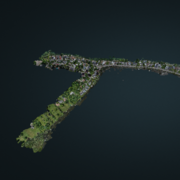Data and Tools
GIS Data
GIS Data
USGS is a primary source of Geographic Information Systems (GIS) Data. Our data and information is presented both spatially and geographically including The National Map, Earth Explorer, GloVIS, LandsatLook, and much more. Start exploring by topic below.
Water Quality Data Viewer for New York
U.S. Geological Survey (USGS) scientists are leading a diverse range of studies to address CyanoHAB issues in water bodies throughout the United States, using a combination of traditional methods and emerging technologies, and in collaboration with numerous partners.
Watershed Regressions for Pesticides (WARP)
The National Water-Quality Assessment (NAWQA) project developed a series of statistical models, based on monitoring data and watershed characteristics, to enable estimation of pesticide concentrations for streams that have not been monitored.
Principal components of climate variation in the Desert Southwest for the time periods 1980-2010, 2040-2070 (RCP8.5) and (RCP4.5) - data release
Five principal components are used to represent the climate variation in an original set of 12 climate variables reflecting precipitation and temperature gradients. The dataset provides coverage for four regions (the Sonoran Desert, Mojave Desert, Colorado Plateau, and Southern Great Basin) and two time periods: current climate (defined as the 1980-2010 normal period) and future climate (...
Water Resources NSDI Node
The Water Resources NSDI Node, or "Water Node", contains geospatial datasets related to USGS water-resources analyses. All data on the Water Node are free to the public.
U.S. Wind Turbine Database
The USWTDB Viewer, created by the USGS Energy Resources Program, lets you visualize, inspect, interact, and download the most current USWTDB through a dynamic web application. The USWTDB provides onshore & offshore wind turbine locations in the United States, corresponding facility...
DATA RELEASE - Variable Terrestrial GPS Telemetry Detection Rates: Parts 1 - 7—Data
Here we explore environmental effects on GPS fix acquisition rates across environmental conditions and detection rates for bias correction of terrestrial GPS-derived large mammal habitat use. We also evaluate patterns in missing data that relate to potential animal activities that change the orientation of antennae and characterize home-range probability of GPS detection for four species.
FWS McGregor District Mast Hardwood Floodplain Forest Community
Due to a gap in information on regeneration of hard-mast trees in the floodplain, interpretation was completed of existing 8“/pixel imagery delineating hardwood forest within the floodplain forest of the Fish and Wildlife Upper Mississippi National Wildlife & Fish Refuge, McGregor District. The detailed map of bottomland hardwoods will allow for the identification
Future changes in southcentral U.S. wildfire probability due to climate change
Globally, changing fire regimes due to climate is one of the greatest threats to ecosystems and society. This dataset presents projections of historic and future fire probability for the southcentral U.S. using downscaled climate projections and the Physical Chemistry Fire Frequency Model (PC2FM, Guyette et al., 2012).
Geospatial Data for Object-Based High-Resolution Classification of Conifers within Greater Sage-Grouse Habitat across Nevada and a Portion of Northeastern California
These products were developed to provide scientific and correspondingly spatially explicit information regarding the distribution and abundance of conifers (namely, singleleaf pinyon (Pinus monophylla), Utah juniper (Juniperus osteosperma), and western juniper (Juniperus occidentalis)) in Nevada and portions of northeastern California.
The National Map
The National Map is a collaborative effort among the USGS and other Federal, State, and local partners to improve and deliver topographic information for the Nation. It has many uses ranging from recreation to scientific analysis to emergency response. The National Map is easily accessible for display on the Web, as products and services, and as downloadable data.
The National Map
The National Map is a collaborative effort among the USGS and other Federal, State, and local partners to improve and deliver topographic information for the Nation. It has many uses ranging from recreation to scientific analysis to emergency response. The National Map is easily accessible for display on the Web, as products and services, and as downloadable data.
Aerial imagery and photogrammetric products from unmanned aerial systems (UAS) flights over the Lake Ontario shoreline at Braddock Bay, New York, July 10 to 11, 2017
Low-altitude (80-100 meters above ground level) digital images were obtained from a camera mounted on a 3DR Solo quadcopter, a small unmanned aerial system (UAS), in three locations along the Lake Ontario shoreline in New York during July 2017. These data were collected to document and monitor effects of high lake levels, including shoreline erosion, inundation, and property damage.












